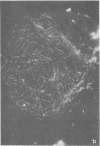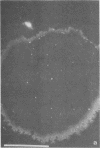Abstract
A serious problem in the technology of plant cell culture is that isolated protoplasts from many species are reluctant to divide. We have succeeded in inducing consecutive divisions in a “naturally” arrested system—i.e., protoplasts from a hibiscus cell line, which do not divide under standard conditions—and in an artificially arrested system—i.e., colchicine-inhibited callus protoplasts of Nicotiana glutinosa, which do readily divide in the absence of colchicine. In both cases, the reinstallation of a net of cortical microtubules, which had been affected either by colchicine or by the protoplast isolation procedure, resulted in continuous divisions of the formerly arrested protoplasts. Several compounds known to support microtubule assembly in vitro were tested for their ability to promote microtubule assembly in vivo. Best results were obtained by addition of dimethyl sulfoxide to the culture medium. Unlimited amounts of callus could be produced with the dimethyl sulfoxide method from protoplasts which never developed a single callus in control experiments.
Keywords: colchicine, hibiscus, Nicotiana glutinosa, plant tubulin
Full text
PDF




Images in this article
Selected References
These references are in PubMed. This may not be the complete list of references from this article.
- Erdei L., Vigh L., Dudits D. Isolation of a wheat cell line with altered membrane properties. Plant Physiol. 1982 Mar;69(3):572–574. doi: 10.1104/pp.69.3.572. [DOI] [PMC free article] [PubMed] [Google Scholar]
- Fuller G. M., Brinkley B. R., Boughter J. M. Immunofluorescence of mitotic spindles by using monospecific antibody against bovine brain tubulin. Science. 1975 Mar 14;187(4180):948–950. doi: 10.1126/science.1096300. [DOI] [PubMed] [Google Scholar]
- Gamborg O. L., Miller R. A., Ojima K. Nutrient requirements of suspension cultures of soybean root cells. Exp Cell Res. 1968 Apr;50(1):151–158. doi: 10.1016/0014-4827(68)90403-5. [DOI] [PubMed] [Google Scholar]
- Hahne G., Hoffmann F. The effect of laser microsurgery on cytoplasmic strands and cytoplasmic streaming in isolated plant protoplasts. Eur J Cell Biol. 1984 Mar;33(2):175–179. [PubMed] [Google Scholar]
- Himes R. H., Burton P. R., Gaito J. M. Dimethyl sulfoxide-induced self-assembly of tubulin lacking associated proteins. J Biol Chem. 1977 Sep 10;252(17):6222–6228. [PubMed] [Google Scholar]
- Kumar N. Taxol-induced polymerization of purified tubulin. Mechanism of action. J Biol Chem. 1981 Oct 25;256(20):10435–10441. [PubMed] [Google Scholar]
- Lee J. C., Timasheff S. N. In vitro reconstitution of calf brain microtubules: effects of solution variables. Biochemistry. 1977 Apr 19;16(8):1754–1764. doi: 10.1021/bi00627a037. [DOI] [PubMed] [Google Scholar]
- Lyman G. H., Papahadjopoulos D., Preisler H. D. Phospholipid membrane stabilization by dimethylsulfoxide and other inducers of Friend leukemic cell differentiation. Biochim Biophys Acta. 1976 Oct 19;448(3):460–473. doi: 10.1016/0005-2736(76)90300-x. [DOI] [PubMed] [Google Scholar]
- Morejohn L. C., Bureau T. E., Tocchi L. P., Fosket D. E. Tubulins from different higher plant species are immunologically nonidentical and bind colchicine differentially. Proc Natl Acad Sci U S A. 1984 Mar;81(5):1440–1444. doi: 10.1073/pnas.81.5.1440. [DOI] [PMC free article] [PubMed] [Google Scholar]
- Robinson J., Engelborghs Y. Tubulin polymerization in dimethyl sulfoxide. J Biol Chem. 1982 May 25;257(10):5367–5371. [PubMed] [Google Scholar]






